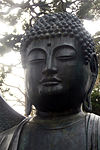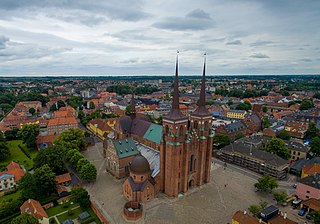| Part of a series on |
| Western Buddhism |
|---|
 |
Buddhism is a minority religion in Denmark with approximately 64,000 members (1.1%) in 2018. [1]
| Part of a series on |
| Western Buddhism |
|---|
 |
Buddhism is a minority religion in Denmark with approximately 64,000 members (1.1%) in 2018. [1]
In the 19th century, knowledge about Buddhism was brought back from expeditions that explored the Far East but interest was mainly from authors, Buddhologists and philologists. In 1921, Christian F. Melbye founded the first Buddhist Society in Denmark, but it was later dissolved in 1950 before his death in 1953. In the 1950s, there was a revival in interest towards Buddhism, especially Tibetan Buddhism. Hannah and Ole Nydahl founded the first Karma Kagyu Buddhist centers in Copenhagen. The third wave of Buddhism came in the 1980s, when refugees from Vietnam, Sri Lanka and China came to Denmark. Some Buddhist women, especially those from Thailand, came to Denmark seeking Danish husbands. [2]
Accurate figures for the number of Buddhists in Denmark is not known, as it is illegal to record people's faiths in Denmark. However, according to Jørn Borup (Department of the Study of Religion, Aarhus University), there are approximately 30,000 Buddhists in Denmark today, [3] of which 80% are Asian immigrants. Of these, 9,000 are from Vietnam and 10,000 are from Thailand. [3] Despite Buddhism being a minority religion, the Dalai Lama is the Danes' preferred religious role model. [4]
According to the latest Eurobarometer estimates, as of December 2018, 1.1% of Danish people are Buddhists. After Christianity and non-religious, Buddhism is the third largest religion in Denmark. [1]
There are 43 Buddhist groups in Denmark, 15 of which have official status as 'recognized congregations'. While the number of members and users of the groups are typically small, the 'convert groups' mainly oriented towards Tibetan and Zen Buddhism outnumber the few Asian Buddhist groups, whose number of 'adherents' nevertheless are much higher [5] [6] .
Theravada Buddhism in Denmark is practised primarily by Thais and Sri Lankans and between 90 and 95% of the 10,000 Danish Thais are Buddhists. Thai Buddhist temples include the Watpa (Thai Language = วัดป่าโคเปนฮาเกน) in Copenhagen, Wat Thai Denmark Brahmavihara Buddhist Monastery (Thai Language = วัดไทยเดนมาร์กพรหมวิหาร) and the Wat Phra Dhammakaya Denmark (Thai Language = วัดพระธรรมกายเดนมาร์ก). [7] These Buddhist émigrés seem almost invisible in Denmark, partly because Buddhism is generally not an evangelical religion, and they rarely take part in the larger social debate, partly because they have low unemployment and crime rates and are therefore not particularly newsworthy subjects for the media. [8] Especially the Vietnamese have attracted such positive views which might be related to their generally positive, cultural integration. [9] Although not directly related to Buddhism as a practiced religion, Buddhism's contribution to popular culture, media and marketing should not be underestimated. [10]
The first Tibetan Buddhist group was founded in Denmark by Hannah and Ole Nydahl. It belongs to the Karma Kagyu lineage, one of the major Tibetan schools. The very first center was opened in Copenhagen in 1972 and relocated in 1975 to its current location. To this day Diamond Way Buddhism has increased to nearly 600 centers worldwide. [11] Although members of this group has not been growing for the last ten years, it is still the largest Vajrayana school in Denmark, with 500 Danish affiliates. [6]
The Soka Gakkai International (SGI-DK) organization was established in Denmark in 1983 and had approximately 1,100 members in 75 local groups in 2015. [7] [12]
Zen is amongst the smallest schools of Buddhism in Denmark. It has five groups (both Soto and Rinzai) and no more than 100 practitioners. [7]
In 1991, the Tibetan-born Lakha Lama tried to establish a trans-sectarian Buddhist umbrella organization called the Buddhist Forum and since 1993 it has been a member of the European Buddhist Union despite having only two hundred paying members. Another Lakha Lama project called Phendeling has subsequently taken over its role and now includes some non-Vajrayana Buddhist groups. Two groups, the Diamond Way Buddhism and Soka Gakkai International, have reportedly not been invited to join the umbrella organizations. In the early 1990s, there was a split between Ole Nydahl and the rest of the groups during the Karmapa controversy. One of two candidates was about to be chosen as the one new reincarnation of the 16th Karmapa. Ole Nydahl supported Trinley Thaye Dorje whilst Urgyen Trinley Dorje was supported by most other Buddhist groups and the Dalai Lama. [13]
The exiled Tibetan leader, the Dalai Lama has visited Denmark several times. He first visited in 1973 to help inaugurate the first Karma Kagyu center founded by the Nydahls. [14] He came back in 1996 for an official visit, but was not met by the Danish prime minister at that time, Poul Nyrup Rasmussen, who said that he was too busy, which he said again the next time the Dalai Lama visited in 2000. However, he did meet him at the airport just before he left. [15]
In 2003, the Dalai Lama returned and was officially welcomed by Rasmussen's successor, Anders Fogh Rasmussen, with the backing of the entire government, despite protests from China. [15] [16]
Buddhism in the West broadly encompasses the knowledge and practice of Buddhism outside of Asia in the Western world. Occasional intersections between Western civilization and the Buddhist world have been occurring for thousands of years. The first Westerners to become Buddhists were Greeks who settled in Bactria and India during the Hellenistic period. They became influential figures during the reigns of the Indo-Greek kings, whose patronage of Buddhism led to the emergence of Greco-Buddhism and Greco-Buddhist art. There was little contact between the Western and Buddhist cultures during most of the Middle Ages but the early modern rise of global trade and mercantilism, improved navigation technology and the European colonization of Asian Buddhist countries led to increased knowledge of Buddhism among Westerners. This increased contact led to various responses from Buddhists and Westerners throughout the modern era. These include religious proselytism, religious polemics and debates, Buddhist modernism, Western convert Buddhists and the rise of Buddhist studies in Western academia. During the 20th century, there was a growth in Western Buddhism due to various factors such as immigration, globalization, the decline of Christianity and increased interest among Westerners. The various schools of Buddhism are now established in all major Western countries making up a small minority in the United States, Europe, Australia and New Zealand.
The relationship between Buddhism and sexual orientation varies by tradition and teacher. According to some scholars, early Buddhism appears to have placed no special stigma on homosexual relations, since the subject was not mentioned.

Ole Nydahl, also known as Lama Ole, is a lama providing Mahamudra teachings in the Karma Kagyu school of Tibetan Buddhism. Since the early 1970s, Nydahl has toured the world giving lectures and meditation courses. With his wife, Hannah Nydahl (1946-2007), he founded Diamond Way Buddhism, a worldwide Karma Kagyu Buddhist organization with over 600 centers for lay practitioners.

Hannah Nydahl (1946–2007), wife of Lama Ole Nydahl, was a Danish teacher and translator in the Karma Kagyu lineage of Tibetan Buddhism.

The term American Buddhism can be used to describe all Buddhist groups within the United States, including Asian-American Buddhists born into the faith, who comprise the largest percentage of Buddhists in the country.

The Sixteenth Gyalwa Karmapa, Rangjung Rigpe Dorje was the spiritual leader of the Karma Kagyu lineage of Tibetan Buddhism. He is of the oldest line of reincarnate lamas in Vajrayana Buddhism known as the Karmapas, whose coming was predicted by the Buddha in the Samadhiraja Sutra. The 16th Karmapa was considered to be a "living Buddha" and was deeply involved in the transmission of the Vajrayana Buddhism to Europe and North America following the Chinese invasion of Tibet. He had many monikers, including "King of the Yogis", and is the subject of numerous books and films.

Kalu Rinpoche was a Tibetan Buddhist lama, meditation master, scholar and teacher. He was one of the first Tibetan masters to teach in the West.
Buddhism is not officially recognized as a religion in Slovakia. As of January 2021, Buddhists numbered 6,722 or 0.12% of the population.

Diamond Way Buddhism is a lay organization within the Karma Kagyu school of Tibetan Buddhism. The first Diamond Way Buddhist center was founded in 1972 by Hannah Nydahl and Ole Nydahl in Copenhagen under the guidance of Rangjung Rigpe Dorje, 16th Karmapa. Today there are approximately 650 centers worldwide, directed by Ole Nydahl under the guidance of Trinley Thaye Dorje, one of two claimants to the title of the 17th Karmapa. Buddhist teachers such as Sherab Gyaltsen Rinpoche, Lama Jigme Rinpoche and Nedo Kuchung Rinpoche visit Diamond Way Buddhism centers and large meditation courses.

Mipham Chokyi Lodro, also known as Kunzig Shamar Rinpoche, was the fourteenth Shamarpa of the Karma Kagyu school of Tibetan Buddhism. The Shamarpa is the second-most important teacher of the Karma Kagyu school, after the Karmapa.

Buddhism is the third largest religion in France, after Christianity and Islam.

Christianity is the largest religion in Denmark. As of 2024, 71.2% of the population of Denmark were registered members of the Church of Denmark, the officially established church, which is Protestant in classification and Lutheran in orientation.

Although there was regular contact between practising Buddhists and Europeans in antiquity the former had little direct impact. In the latter half of the 19th century, Buddhism came to the attention of Western intellectuals and during the course of the following century the number of adherents has grown. There are now between 1 and 4 million Buddhists in Europe, the majority in Italy, Germany, Hungary, France and the United Kingdom.

Buddhist traditions are represented in South Africa in many forms. Although the inherently introspective nature of Buddhism does not encourage census, adherents to these traditions are usually outspoken and supported by perhaps an even greater, though hidden number of sympathisers. Temples, centres and groups are common in the metropolitan areas and the country is thought to comprise the largest Buddhist community in Africa.

Alexander Berzin is a scholar, translator, and teacher of Tibetan Buddhism.

The roots of Buddhism in Poland can be found in the early 20th century in the nation's connections to the origin countries of the religion, like Vietnam, China, Japan, and Korea. After World War II, primarily expatriate Poles joined various Buddhist groups and organizations. Since the breakdown of the Eastern Bloc, which had promoted an antireligious campaign, Buddhism has been able to develop further in the more tolerant atmosphere.

Buddhism is a major religion in Hong Kong and has been greatly influential in the traditional culture of its populace. Among the most prominent Buddhist temples in the city there are the Chi Lin Nunnery in Diamond Hill, built in the Tang dynasty's architectural style; the Po Lin Monastery on Lantau Island, famous for the outdoor bronze statue, Tian Tan Buddha, which attracts a large number of visitors during the weekends and holidays.

Buddhism in the United Kingdom is the fifth-largest religious group in the United Kingdom. The 2021 United Kingdom census recorded just under 290,000 Buddhists, or about 0.4% of the total population, with the largest number of Buddhists residing in Greater London and South East England. According to a Buddhist organisation, the growth of Buddhism in the United Kingdom is mainly a result of conversions.
Buddhism is a small minority religion in the Netherlands, but it has shown rapid growth in recent years. As of the 2006 estimate, 170,000 Dutch people identified their religion as Buddhist.

The Kagyu-Dzong center is a Buddhist center in Paris, affiliated to the Karma Kagyu school of Tibetan Buddhism. This center is linked to the 17th Karmapa, Orgyen Trinley Dorje.